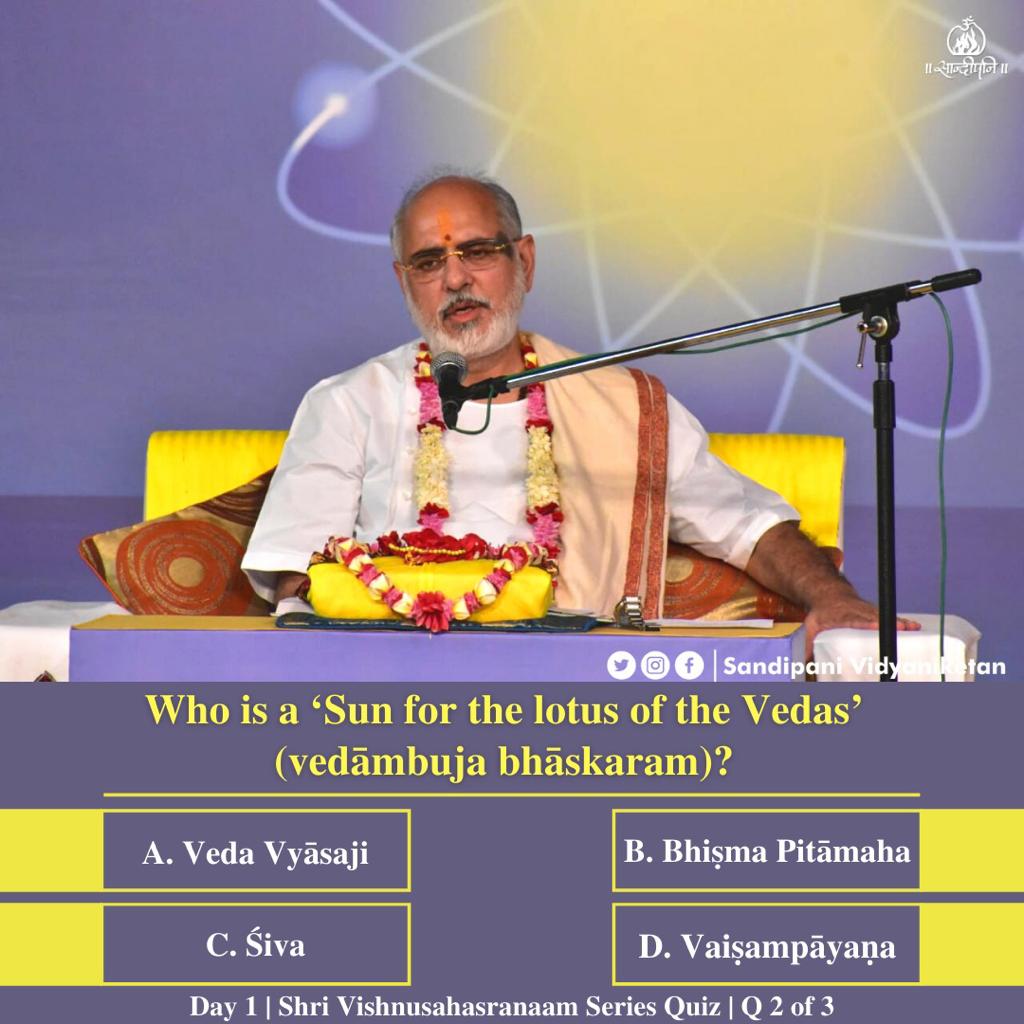Garland of Talks – a Thousand Names of the Lord
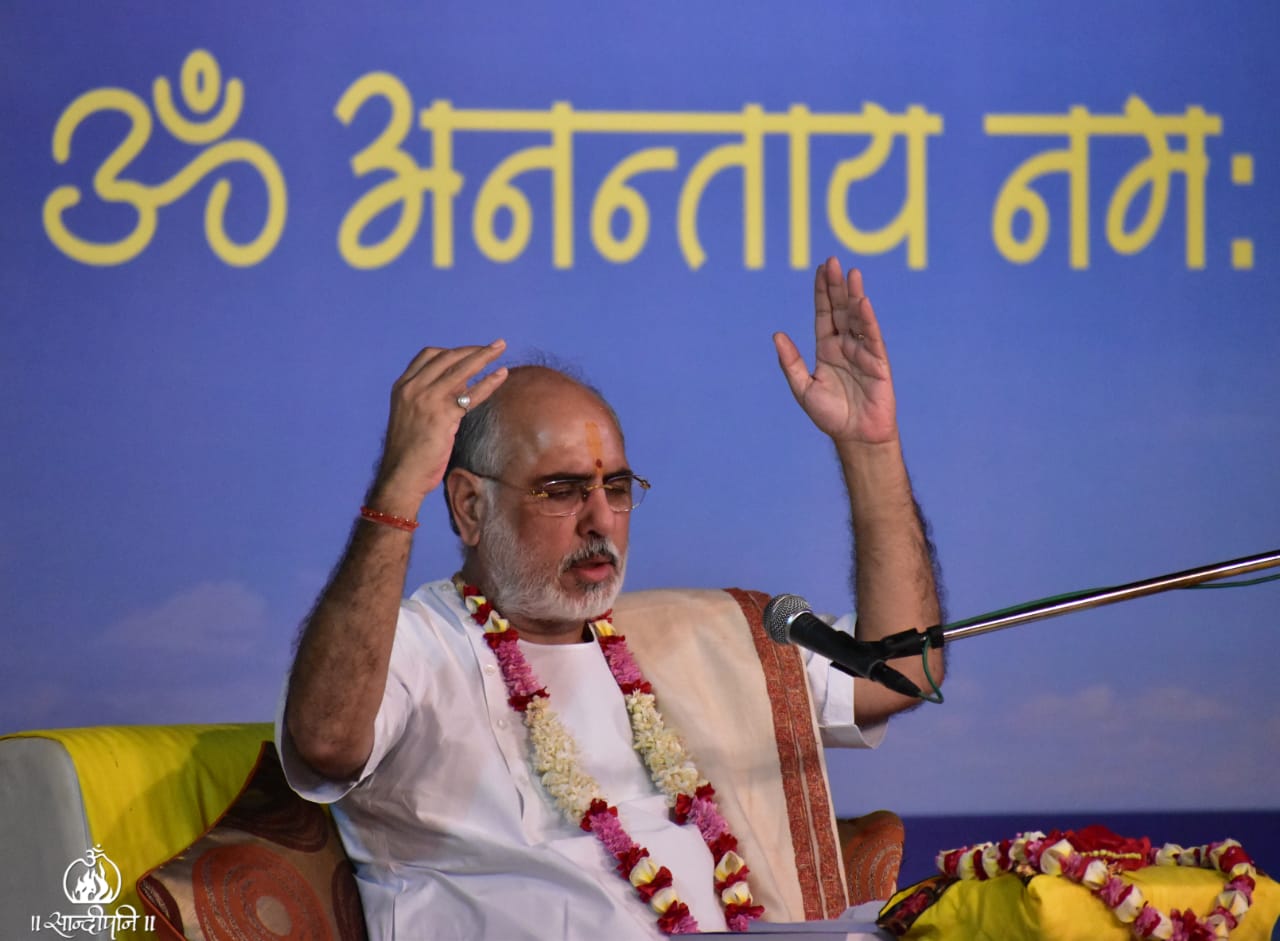
The first day of the eleven-day ‘Śrī Viṣṇusahasranāma Stotram’ lecture series commenced with Pujya Bhaishri describing the unique significance of this powerful collection of the Lord’s Names, both within the Māhābhārata and within the life journey of Bhagavāna Adi Śhankarcārya.
This ‘Garland of Talks’ shall be based primarily upon the commentary and interpretations of the numerous names in this hymn written by the great scholar and incarnation of Lord Śiva, Ādī Śankarācarya.
Many modern-day saints (such as Swami Akhandanand Saraswati) and scholar-philosophers (Shri Vinoba ji) have further expounded upon these meanings and Pujya Bhaishri shall continue to refer to these as we progress.
Three-Versed Invocation
All sacred expositions begin with an invocation called a ‘Mangalācaraṇa’. Bhagavāna Ādyaśankarācārya has first paid homage to Śrī Krṣṇa, the Bliss-incarnate Supreme Guru and then paid homage to Śrī Veda Vyāsa, the Sun for the lotus of the Vedas (Knowledge) to bloom. In the third verse he states the purpose of writing this exposition upon the thousand Names of the Supreme Lord- cessation of the suffering of birth, old age and other miseries.
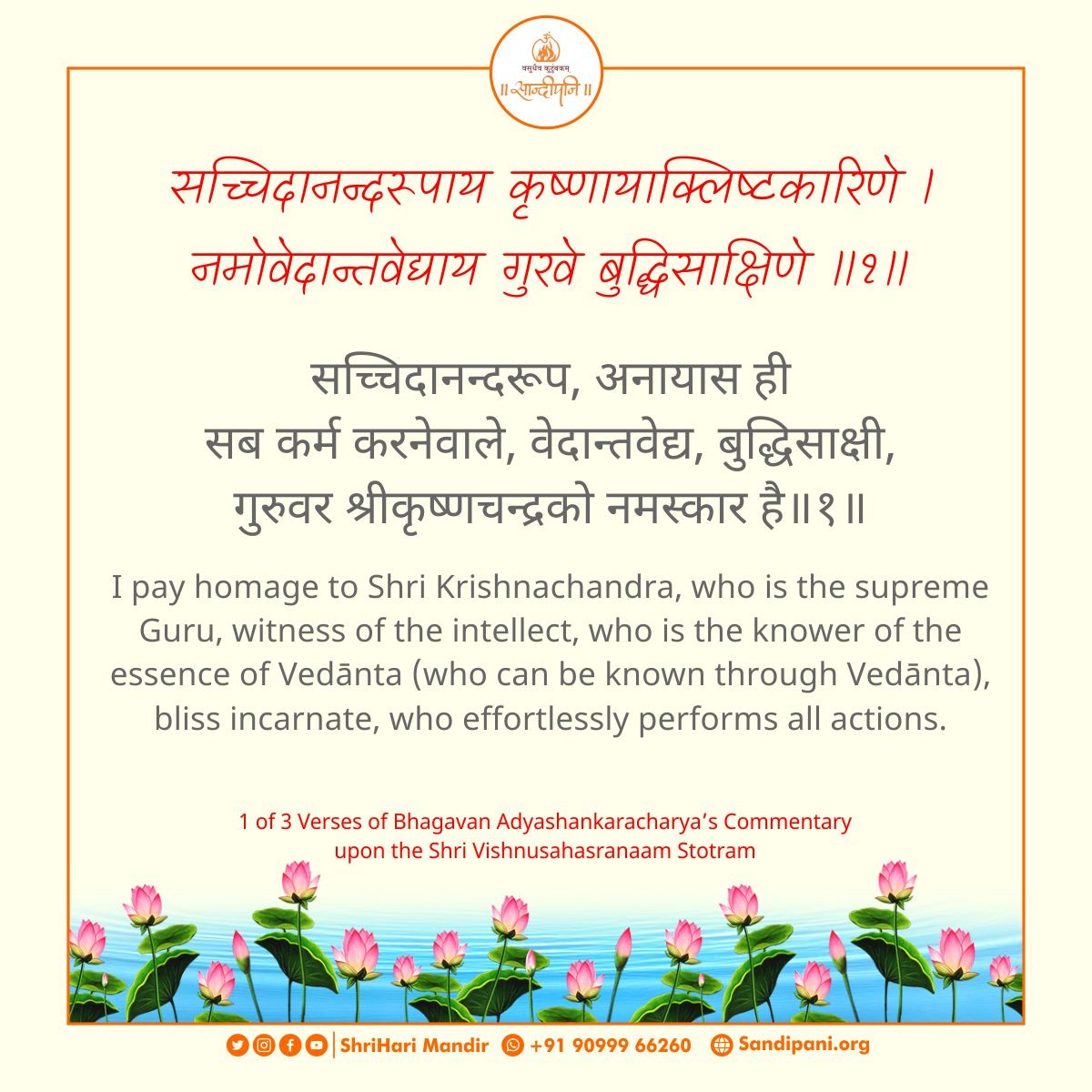
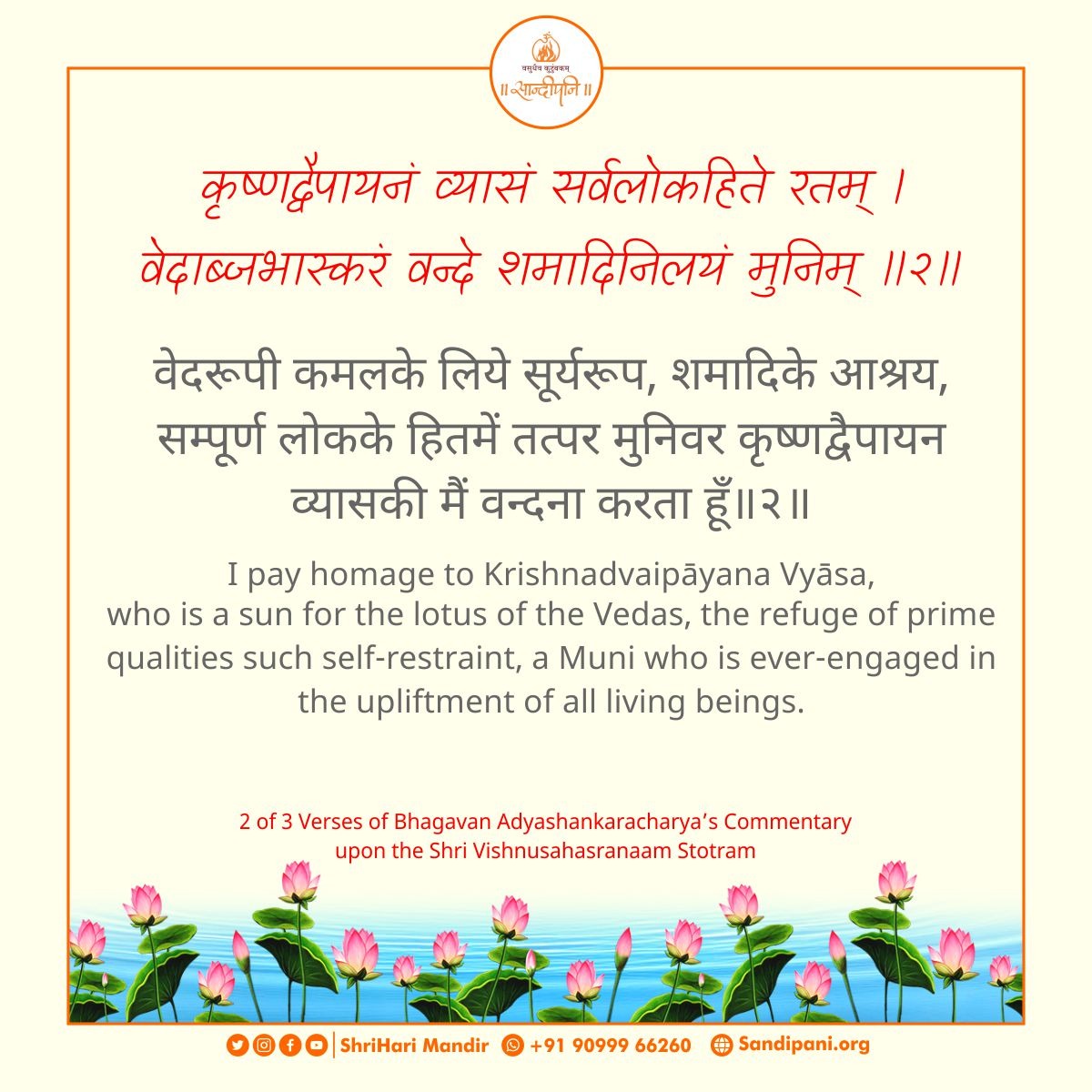
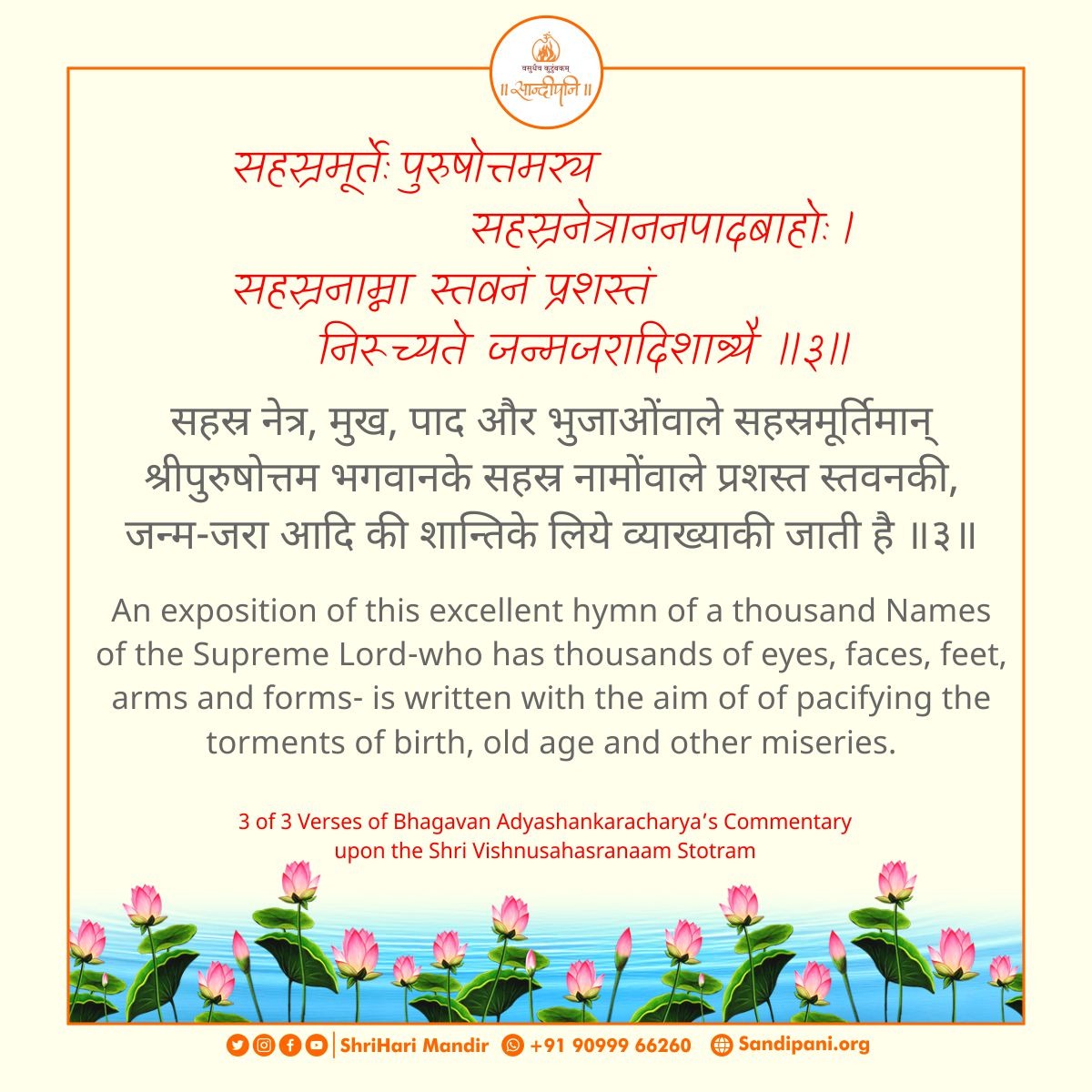
Even a fool does not undertake any activity without a purpose; and Bhagavāna Ādyaśankarācārya is an unparalleled scholar, as seen very early on in his relatively short (32 years) yet extraordinary life.
Whilst studying under his Guru, Śrī Govindapādācārya, he would write a sutra daily upon a board which would be erased later (it is said, by the Goddess Sarasvati). However, when he began to write about the Vishnusahasranām, the text remained. Upon sharing these
sutras with His Guru, he received direction by Śrī Govindapādācārya to proceed to write this exposition .
Peace in the various states of existence which all embodied souls pass through, from birth (janma) to old age (jarā), is Bhagavāna Ādyashankarāchārya’s purpose in composing this commentary upon the Lord’s 1000 Names
The term ‘Janma’ (birth) indicates the state of bondage in the cycle of rebirth which realized souls such as Bhagavāna Ādyashankarāchārya are ever free from.
Liberation is not a banishment to some other realm but rather the absolute freedom, to both come and go, as they wish. For such souls, they take birth out of free will to fulfill a divine purpose rather than be born to bear the consequences of their previous actions (Karma). Ultimately, it is the quality of our life that determines our longevity, not the length of our lifespan!
The Five Gems
The Viṣṇūsahasranām Stotram is one of the five major Gems (Panća Ratna) found within the historical treatise. These are the –
1. ŚrimadBhagavadGītā; 2. ŚrīViṣṇūsahasranāma; 3. Anusmrti(anugītā);
4. BhīṣmaStavarāja;
5. GajendraMokṣa.
The Context
Our scriptures are conversations that commence with a sincere question, leading to the upliftment of the questioner, speaker and audience. Primarily, the Mahābhārata is a conversation between Muni
Vaiśampāyana (disciple of Śrī Veda Vyāsa) and Emperor Janmajaya (son of Emperor Parikṣita) with multiple nested conversations within it.
The Dilemma of Dharma
Muni Vaishampayana is narrating one such exchange on the sacred land of the Great War, Kurukṣetra, between the victorious yet desolate King Yuddhishtira, who is the embodiment of Dharma, and a fallen Bhishmapitāmāha, whose very name indicates a life dedicated to upholding a grim pledge in the name of Dharma.
This battlefield has born witness to both Arjuna’s dejection prior to the battle and Yuddhiśtira’a dejection post battle. Whilst the Lord (Nārāyana) dispelled (Nara) Arjuna’s delusion through his divine song of Self-Realization called the ‘Śrimada Bhagavad Gītā’, the delusion of Dharma must be dispelled by Saints. After all, Dharma has a universal and all-encompassing definition-
‘yato abhyudaya nihśreyasa siddhi sa dharma.’
That which leads to the cessation of grief and attainment of upliftment, both in this world and the next, is Dharma. Even after a detailed discussion upon all forms of Dharma, Yuddhiṣtira was not satisfied and so he asked these six important questions.
The Six Questions
Just as the Shrimad Bhāgavatam commences with six questions about the Lord who possesses six opulences (Bhagavāna), so too does this Viṣṇusahasranāma commence with six questions posed by King Yuddhishira (four in the first verse, and the fifth and sixth in the following verses):
1. Kimékam daivatham loke
2. Kim vápyekam parãyanam
3. Sthuvantha kam
4. Kamarchanda prapnuyur mãnavã shubam
5. Ko dharma sarva dharmãnam bhavatha paramo mathaha 6. Kim japan muchyathé janthur janma samsãra bandhanãth.
Who is the greatest (single) Dev in the world; who is a great source of Light and knowledge; whose ordinance all obey; who is the most excellent goal to be attained, realising which nothing remains to be attained? Which form of Dharma is the greatest amongst all? Which Name liberates man from the bondage of birth and death when chanted?
The Glory of Japa Yagya
Pujya Bhaishri concluded the lecture by explaining how chanting of the Lord’s Names (Japa-Yagya), is ‘sukha-sādhya’—easily achievable, as there is no need to select the right (pure) land, auspicious time, peaceful place (or bank of a river), incur any expenses or need the assistance of any other to perform.
The Lord has called such a Japa Yagya to be His own form.
Do stay connected to learn more about why the Lord and His Names are non-different from one another….
Program begins with a brief English summary daily by Shri Vibhootiben, Shri Bhavyangbhai Acharya (exclusively for ZOOM viewers) followed by chanting of the Stotram by Shri Shyambhai Thakar for purification of mind and pronunciation and thereafter by Pujya Bhaishri’s lecture.
Test your knowledge of this series with our Quiz Series https://bit.ly/VSNQuiz
Download the entire PDF now
Day 1 Shri Vishnusahasranaam Pravachan by Pujya Bhaishri, 26.11.2020
Report by Nimisha Sadhu and Shivani Suchak
